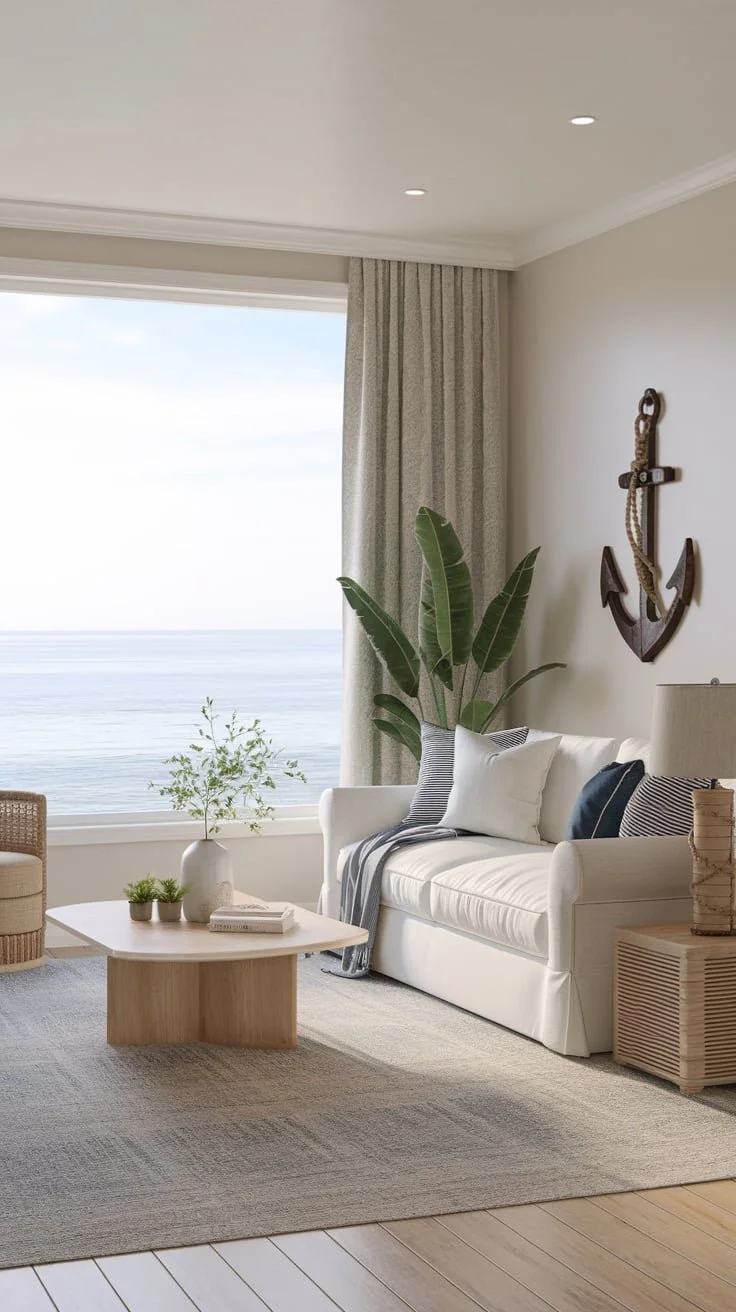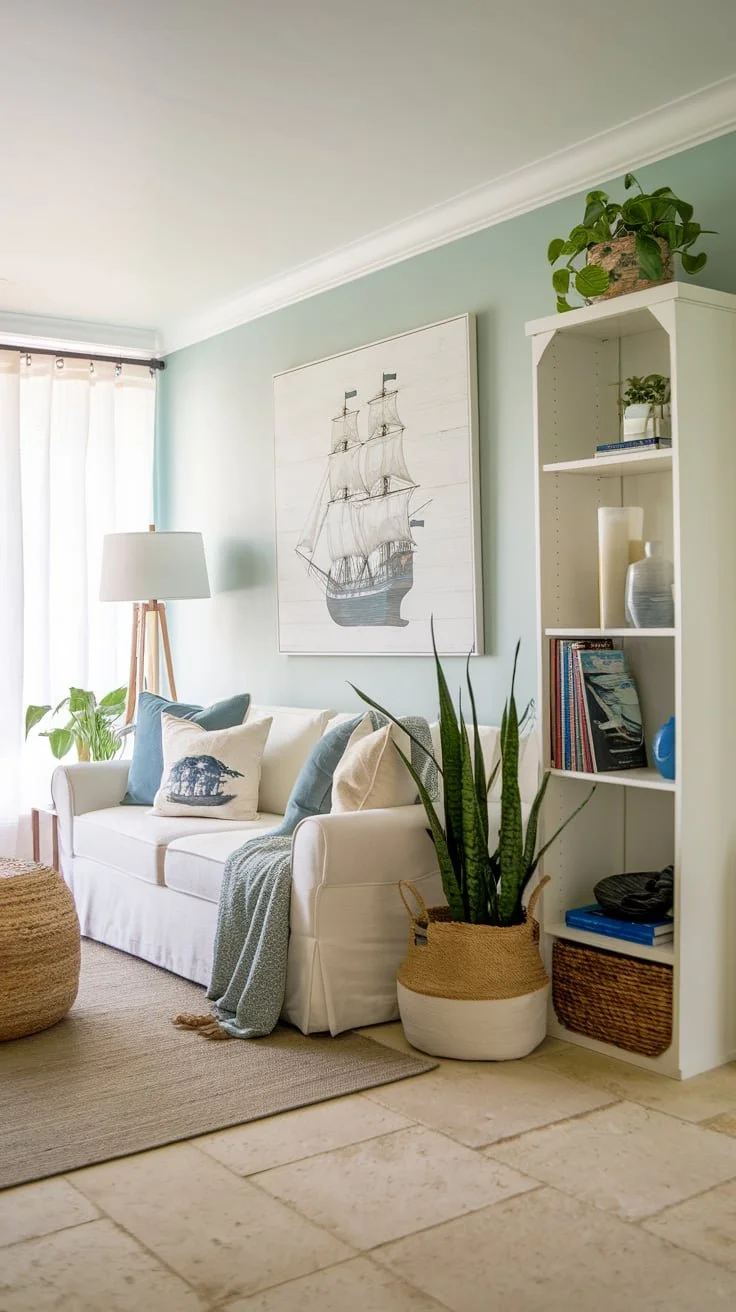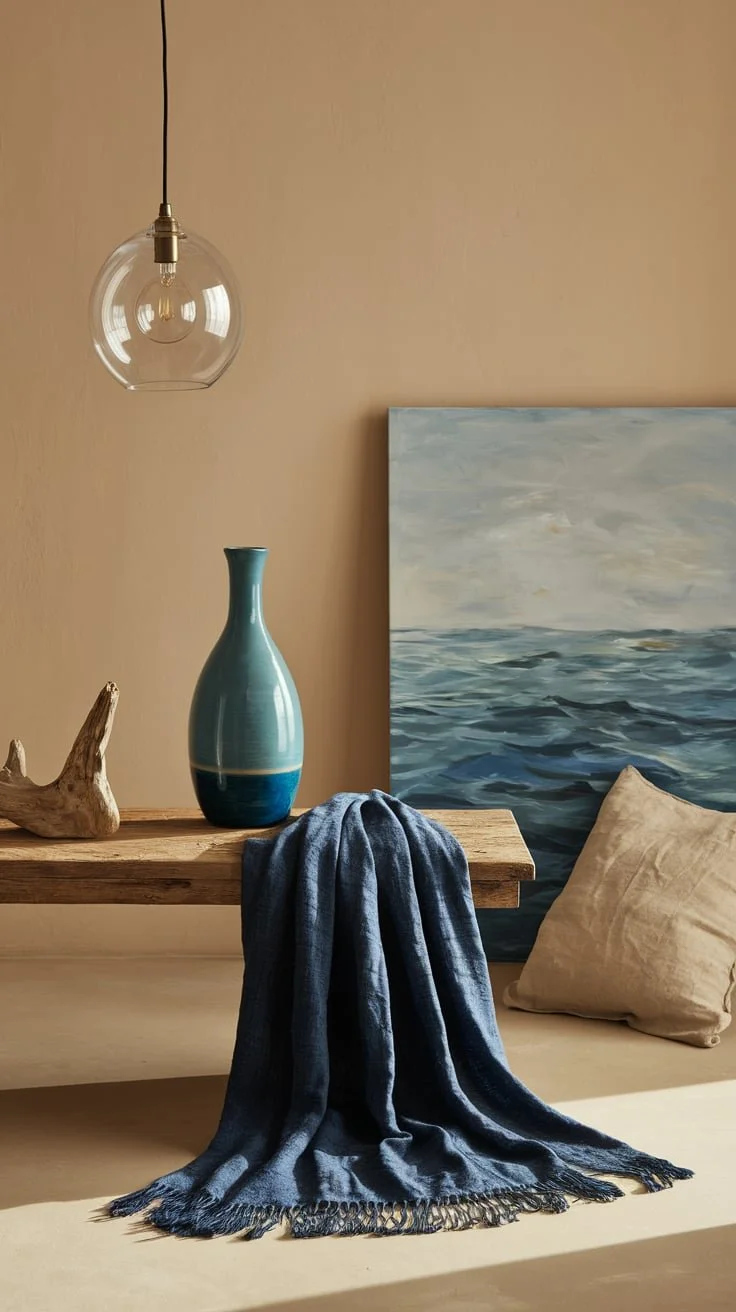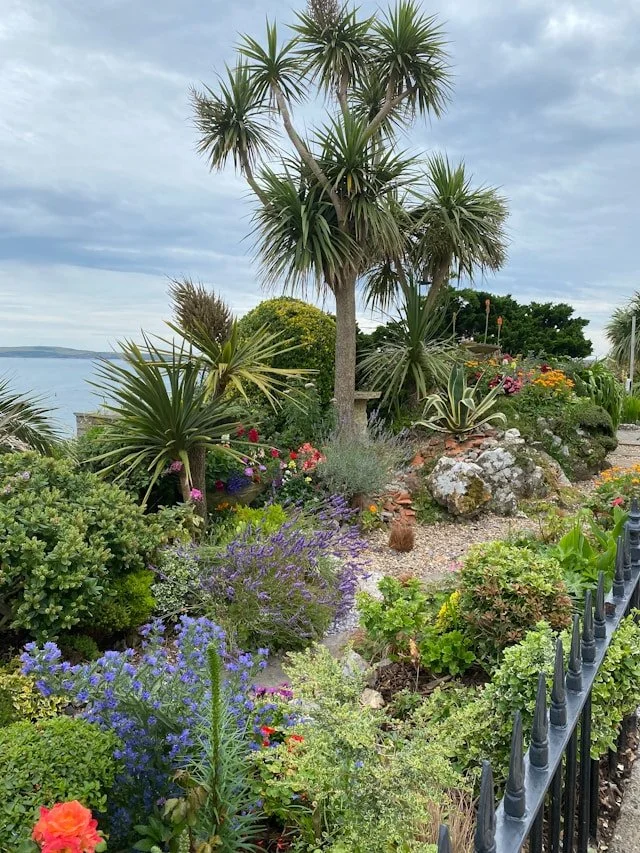Is Nautical Minimalism Right for You? A Refined Coastal Aesthetic
This post may contain affiliate links. If you make a purchase through one of my links, I may receive a small commission at no cost to you.
If you've been scrolling through home decor inspiration lately, you might have noticed something interesting happening to coastal aesthetics.
Gone are the days when nautical décor meant plastering every surface with anchors, rope, and seashells.
Now, as a disclaimer, there is nothing wrong with a nautical-themed home, especially if you are decorating an AirBNB or you have a lot of unique vintage nautical decor and you’re a maximalist…it’s all good!
But I do want to talk about the emergence of, what I like to call "Nautical Minimalism", that is showing up in many coastal homes (especially new builds), that combines the love for seaside living with clean, intentional design principles.
Photo by Carly Jenkins; Location: Oak Island, NC
What Is Nautical Minimalism?
Remember when coastal décor meant navy and white stripes everywhere, with fishing nets draped across walls and those ubiquitous "Beach This Way" wooden signs? While there's certainly charm in traditional nautical themes, many of us have found ourselves craving something a bit more... breathable.
That's exactly where Nautical Minimalism comes in. It's like that friend who knows exactly how to dress for every occasion without looking like they're trying too hard.
This emerging trend maintains the essence of coastal living while embracing the "less is more" philosophy that has dominated interior design in recent years.
Photo by Carly Jenkins; Location: Sunset Beach, NC
"I've always loved the ocean and wanted my home to reflect that," shares Marina Cohen, a solo-renovator and friend who recently redecorated her coastal home in our Myrtle Beach area. "But I found that traditional nautical décor could sometimes feel like living in a themed restaurant. Nautical Minimalism allows you to honor that connection to the coast without sacrificing sophistication."
How Did The Nautical Design Evolve?
To appreciate where we're heading with Nautical Minimalism, it helps to understand where we've been.
Traditional nautical décor has deep historical roots, originating from actual maritime tools and artifacts. What began as functional transformed into decorative over decades, and typically includes:
Bold navy and white color schemes
Abundant use of rope details
Collections of seashells and starfish
Replica ships, lighthouses, and anchors
Weathered wood and fishing nets
Signs with coastal sayings and nautical motifs
Image is ai-generated
While these elements certainly evoke a sense of seaside charm, they can sometimes overwhelm a space, making it feel cluttered or thematic rather than livable.
The shift toward Nautical Minimalism began gradually, as broader minimalist design principles started influencing every corner of the interior design world. People began questioning, "Do I really need seventeen anchor-shaped objects in my living room?"
Left Image: ai-generated; Right Image: Carly Jenkins
What Defines This New Take on Coastal Style?
Basically, this style focuses on a few quality pieces with sentimental value instead of filling every corner with maritime decor and trinkets.
It's about creating a space that feels open, refreshing, neat, decluttered, and instantly calming.
The ocean is a master of simplicity that is constantly polishing, smoothing, and returning everything to its essential nature.
Our homes can reflect that same beautiful wisdom to create a peaceful space.
Clean Lines and Open Spaces
Unlike traditional nautical, which often filled every spot with thematic objects, Nautical Minimalism likes the negative space.
Rooms feature streamlined furniture with simple silhouettes so that the soft textures and subtle tones can emerge from the design. The feeling is one of openness.
"When designing with Nautical Minimalism in mind, I always ask myself if an element serves both form and function," explains, our local home organization expert, Jamie Mathis. "That driftwood coffee table isn't just there because it's coastal – it's there because its organic shape, has the right texture, and can actually hold a drink without it spilling all over."
A Refined Palette Inspired by Nature
Photo by Celeste Monroe
You will not find the in-your-face navy and bright white combinations in this decor style.
Nautical Minimalism draws from a more nuanced coastal palette:
Soft whites that remind you of sea foam
Gentle blues that recall different moods of the ocean
Warm sand tones and pale driftwood grays
Muted sage greens inspired by coastal vegetation
These colors don't scream "BEACH!" they whisper it, creating a backdrop that's both soothing and sophisticated.
The palette tends to be limited to three or four complementary tones throughout a space, creating harmony rather than contrast.
After years of styling my clients’ AirBNBs in bold navy accents, transitioning to a softer palette of misty blues and warm neutrals made their beach houses have that perfect at-home feel.
Subtle Maritime Touches
This part of the Nautical Minimalism style means choosing one exquisite item that speaks volumes over a collection that merely makes noise.
Rather than scattering mass-produced anchor pillows across every surface, you might showcase a single handcrafted cushion made from weathered sails that once crossed the Atlantic.
Photo by Judy Acosta; Location: Ocean Isle Beach, NC
"I've always believed the best maritime pieces tell stories," says Leo Shepard, whose sustainable local home goods line draws from recovered harbor materials. "That perfectly imperfect piece of driftwood sitting on your coffee table? Maybe it traveled thousands of miles before washing ashore during that memorable family vacation. A carefully framed nautical chart might mark the coastline where you first learned to sail or where you got engaged. These aren't just decorations; they're chapters of your personal connection to the water."
Making the Transition to Nautical Minimalism
If you're looking to embrace this emerging trend but aren't sure where to start, don't worry, I've been there too and it’s easier than you think!
The beauty of a minimalist home decor makeover is that it encourages a gradual, thoughtful transition rather than a complete overhaul.
Now, let’s talk about the specifics:
Start With Subtraction
The first step in embracing Nautical Minimalism isn't shopping, it's editing.
Take a look around at your existing coastal décor, and ask yourself which pieces really mean something to you and which ones you've simply accumulated over time.
When I made this transition, I was surprised to discover that out of my extensive collection of seashells, only three or four had genuine meaning and beauty that deserved display status.
The rest were just stuff. It was actually liberating to let go of items that didn't truly enhance my space or bring me joy.
Focus on Texture Over Themes
Photo by Celeste Monroe
One of the most effective ways to maintain a coastal feel without resorting to obvious motifs is to add some textures reminiscent of the seaside:
Natural linen upholstery that recalls canvas sails
Smooth surfaces polished like sea glass
Rough jute rugs that remind you of fishing rope
Weathered wood that tells stories of salt and sun
These elements add depth and interest to a space while keeping the overall aesthetic clean and sophisticated.
Invest in Statement Pieces
Photo by Bryan Arthur; Sponsor: Big Wall Decor
Rather than filling your home with numerous small nautical accessories, consider investing in one or two larger pieces that make a refined maritime statement.
A vintage ship's lantern converted into a pendant light or an authentic porthole mirror can become a conversation piece while maintaining the minimalist approach.
The Environmental Connection
As we become increasingly aware of the fragility of our oceans and coastlines, this design approach feels like a respectful nod to maritime heritage without excessive consumption.
Many decorators who like this minimalist style find themselves naturally drawn to sustainable practices:
Repurposing authentic maritime artifacts rather than buying new replicas
Choosing quality pieces designed to last generations
Selecting natural materials that biodegrade rather than faux synthetic alternatives
Supporting local artisans who work with reclaimed marine materials
"There's a certain mindfulness that comes with Nautical Minimalism," reflects sustainability designer Coraline Jensen. "When you're intentionally selecting fewer objects for your home, you tend to think more deeply about their origins and impact. It's about honoring the ocean in your design choices, not just aesthetically but ethically."
Each carefully chosen piece in my home now tells a story of where I’ve been and with which friend, and it feels authentic rather than commercialized.
And isn’t that what we're truly seeking when we bring coastal elements into our spaces?
Shopping Guide: Key Pieces That Define Nautical Minimalism
Photo by Judy Acosta
OK, so are you ready to add some Nautical Minimalism into your own coastal cottage?
Here's a curated guide of the essential elements to look out for as well as links to items to show you options:
Furniture
The Driftwood Coffee Table: Look for pieces with organic shapes in pale, weathered wood tones. The silhouette should be simple enough to feel contemporary while the material connects to coastal themes.
Linen Slipcovered Sofa: Opt for comfortable seating in natural fabrics with clean lines. Colors like off-white, pale sand, or soft blue create the perfect backdrop for your minimalist coastal space.
Rattan or Seagrass Accent Chairs: These bring textural interest while maintaining the natural material palette essential to the style. Choose pieces with simpler silhouettes rather than ornately woven patterns.
Lighting
Glass Pendant Lights: Clear or sea glass-inspired lighting fixtures bring the reflective quality of water into your space. Look for simple shapes without too much embellishment.
Rope-Detailed Floor Lamp: A single well-designed floor lamp that incorporates rope detailing can add just enough nautical reference without overwhelming your space.
Dimmable Sconces: Wall-mounted lighting with adjustable brightness helps create that magical quality of shifting coastal light throughout the day.
Textiles
Hand-Dyed Indigo Throw: The ancient technique of indigo dyeing connects deeply to maritime traditions. A single artisanal throw in varying shades of indigo adds depth without dominating.
Natural Fiber Area Rug: Ground your space with sisal, jute, or seagrass in simple patterns or solid colors. These durable materials not only reference nautical rope but stand up to sandy feet!
Linen Window Treatments: Light-filtering linen curtains that move gently in the breeze capture the essence of coastal living without heavy patterns or nautical motifs.
Accessories
Vintage Maritime Maps: A carefully framed navigation chart of a meaningful coastline serves as both art and a subtle nautical reference.
Sculptural Driftwood: A single piece of interestingly shaped driftwood displayed on a simple shelf can be more impactful than dozens of small coastal trinkets.
Artisanal Ceramics in Ocean Hues: Handcrafted vessels in varying shades of blue, green, and neutral tones bring color and craftsmanship to your space.
The Statement Piece
Every Nautical Minimalist space benefits from one magnificent item that anchors the maritime connection:
Vintage Ship's Wheel: Mounted simply on a wall, an authentic wooden ship's wheel becomes functional sculpture.
Reclaimed Boat Wood Dining Table: A table crafted from salvaged marine materials brings history and character to your dining space.
Oversized Black and White Coastal Photography: A breathtaking image of ocean waves or weathered fishing boats makes a sophisticated statement.
Sea-Inspired Simplicity: Beyond the Aesthetic
To be honest, I've come to really appreciate the Nautical Minimalism style.
Because it's not just about what catches the eye, but about how it makes me feel inside…calm and at peace.
It’s like that feeling when you first walk onto an empty beach at sunrise. That incredible expansion in your chest as your breathing naturally slows and deepens?
Photos by: Bryan Arthur; Location: Southern Beaches, NC
That's exactly how I felt in my bedroom when I finally let go of my coastal clutter.
"What I hear from clients after embracing this approach is quite remarkable," wellness architect Sarah Faust shared with me over coffee last month. "It's not just aesthetic preference, science backs this up. Studies show rooms with breathing space and fewer visual distractions actually lower stress hormones. When you layer in those gentle oceanic elements that humans have evolved with for millennia, you're essentially creating a sanctuary for your nervous system."
Where Nautical Minimalism Is Heading
As this trend evolves, I’m seeing reactions that suggest Nautical Minimalism has some staying power and may expand in these areas:
Integration with biophilic design principles, bringing living elements that connect to coastal ecosystems
Addition of sustainable materials recovered from ocean cleanup efforts
Technological elements with maritime heritage, like solar lighting inspired by traditional navigation tools
Community-centered design that celebrates local coastal culture rather than generic beach themes
Photo by Diane Pilkington
The future of Nautical Minimalism isn't about following rigid rules but about continuing to ask thoughtful questions: How can our spaces honor our connection to water? How can design choices reflect care for coastal environments? How can simplicity enhance rather than diminish our experience of maritime influences?
The Gentle Tide of Change
If you're feeling inspired to make the shift toward Nautical Minimalism but overwhelmed by the prospect of change, remember you don't need to toss everything and start fresh.
Begin by removing a few items that no longer serve your decor vision, then thoughtfully integrate new elements that better reflect this refined approach.
Photos by Celeste Monroe and Judy Acosta
For example, start simply by repainting a wall in a softer shade of blue, or by displaying that one perfectly unique shell you found on a meaningful beach walk while putting the rest of your collection in storage.
What matters isn't achieving some perfect Instagram-worthy result overnight, but creating a space that genuinely reflects your connection to coastal living in a way that brings peace rather than visual noise.
The most beautiful beaches aren't the ones covered in countless shells, but those with just enough interesting ones to discover.



















